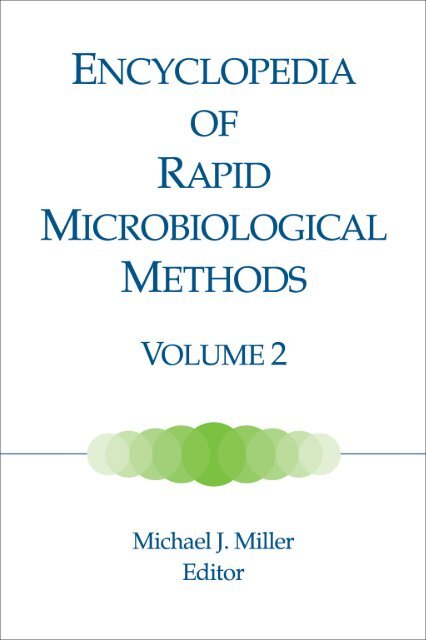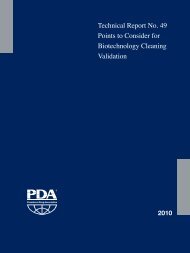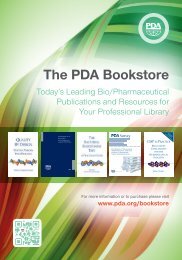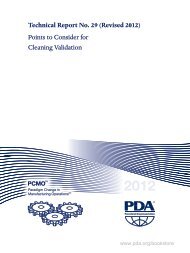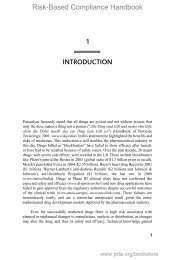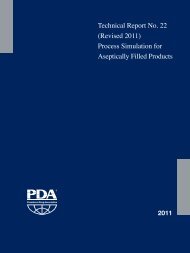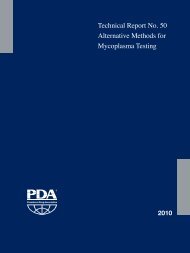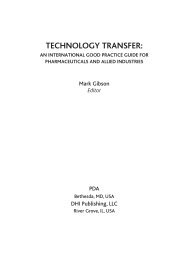Table of contents - GMP-Verlag
Table of contents - GMP-Verlag
Table of contents - GMP-Verlag
- No tags were found...
Create successful ePaper yourself
Turn your PDF publications into a flip-book with our unique Google optimized e-Paper software.
CONTENTSPrefaceForewordDavid HussongMichael J. Millerxixxxi1. Microbial Identification Using thebioMérieux VITEK® 2 System 1David H. PincusObjective 1Principles 1VITEK 2 Compact 2VITEK 2 and VITEK 2 XL 2Reagent Cards 2Culture Requirements 3Suspension Preparation 4Inoculation 4Card Sealing and Incubation 4Optical System 6Test Reactions 6Database Development 6Analytical Techniques 6Identification Levels 6Supplemental Testing 7Non-Reactive Biopattern 8Applications 8GN Card 8GP Card 9YST Card 19BCL Card 23iiiwww.pda.org/bookstore
ivEncyclopedia <strong>of</strong> Rapid Microbiological MethodsValidation Procedure 27Potential New Applications 27Conclusion 27References 27About the Author 322. Detection <strong>of</strong> Microorganisms Using ImpedanceMicrobiology and the bioMerieux Bactometer® System 33Patricia RuleHistory 33Instrument 34Equation 36Theory 36Applications 39CFU Determination 40Bioburden and Microbial Limits 42Sterility Testing 43Antimicrobial Effictiveness/Preservative Efficacy Testing 44Disinfectant/Sanitizer Testing 45Impedance as a Predictive Indicator 48Conclusion 49References 49About the Author 533. Biolog: Modern Phenotypic Microbial Identification 55Barry R. BochnerThe Biolog System and Modernization <strong>of</strong> Phenotypic Testing– An Overview 55A Brief History <strong>of</strong> Microbial Identification 57The Biolog System 59www.pda.org/bookstore
ContentsvProblems with Species Not in the Database 62Retrospective Trending 63Validation <strong>of</strong> Identification Systems 63Perspectives on Phenotypic ID Versus DNA-based ID 64The Basic Steps <strong>of</strong> Phenotypic Testing 65The Importance <strong>of</strong> Standardization and Precisionin the Testing Regime 66Isolation <strong>of</strong> a Pure Culture 66Cultivation on Appropriate Agar Media 67Performance <strong>of</strong> the Gram Stain 68Selection <strong>of</strong> the Appropriate Test Panel 69Preparation <strong>of</strong> the Inoculum 69Inoculation <strong>of</strong> the Panel 70Incubation <strong>of</strong> the Panel 70Reading and Interpretation <strong>of</strong> the Results 70Conclusions and the Future <strong>of</strong> Phenotypic Testing 71References 72About the Author 734. Under the Microscope: Microbial Identifications inPharmaceutical and Biopharmaceutical Quality ControlLaboratories, “An Era <strong>of</strong> Coarse to Fine Adjustment” 75Mary Griffin and Dona ReberRegulatory Considerations 75Methods 78Validation 84Looking Ahead 85Case Study 85Met Assay Acceptance Criteria 87Accepted Identification 87Results and Discussion 88Current Example <strong>of</strong> a Process Flow Approachfor Identification 92www.pda.org/bookstore
viEncyclopedia <strong>of</strong> Rapid Microbiological MethodsSituation 92Solution 92Trending 93QC Pharmaceutical and Biopharmaceutical MicrobiologyLaboratories Meet the Business Need 96Summary 97Conclusion 98References 98About the Authors 1005. The Growth Direct Test: A Rapid, Non-destructive,Automated System for Microbial Enumeration 103Roanna London, Julie Schwedock,Andrew Sage, Michael Michalek,Heather Valley, Joe Lacirignola,Paula Welter, Luis Jimenez,Steven Buhl, and Don StrausMoving Towards Rapid Microbial Enumeration inPharmaceutical Microbiology 103How the Growth Direct Test Works 105Demonstrating Equivalence to Visual Plate Counting 109Imaging Growing Microcolonies Over Time forImproving Accuracy 111Assessing Accuracy at Lowest Levels <strong>of</strong> Contamination 112Dynamic Range 114Detecting a Broad Range <strong>of</strong> Microbes 115Time to Detection for Model Organisms 116Important Parameters Underlying Time to Detection 117The Range <strong>of</strong> Microbes That Can Be Detected When theDuration <strong>of</strong> Culturing is Defined 119Applying the Growth Direct System to Key PharmaceuticalMicrobiology QC Applications 120Rapid Detection <strong>of</strong> Microbes in Water Samples 120Detecting Stressed Microbes 122www.pda.org/bookstore
ContentsviiRapid Detection <strong>of</strong> Microbes in Environmental Air Samples 123Testing Surfaces Using Contact Plates 127Rapid Microbial Limit Testing 129Rapid In-process Bioburden Testing 130Testing the Feasibility <strong>of</strong> a Rapid Sterility Test Using theGrowth Direct System 131Conclusion 133References 134About the Authors 1356. ATP Bioluminescence Using Millipore’s Milliflex®Rapid System 137Serge OhresserIntroduction 137Rapid Detection <strong>of</strong> Microorganisms UsingATP Bioluminescence 137Milliflex Rapid System: Basics and Principles 138Bioluminescent Reaction 138Sample Prep 141Reagent Spraying 142Signal Detection and Image Processing 143How to Validate for Successful Regulatory Acceptance 149Robustness 149Ruggedness 157Accuracy 159Range and Linearity 161Limit <strong>of</strong> Detection 163Precision 164Specificity 165Food and Beverage Industry: Iced Tea 167Conclusions 172References 173About the Author 174www.pda.org/bookstore
viiiEncyclopedia <strong>of</strong> Rapid Microbiological Methods7. ATP Bioluminescence Using the Celsis System 175Lori DaaneIntroduction 175RapiScreen and ATP Bioluminescence 176RapiScreen for Products Low in Background ATP 177Sample Compatilibity 177Organism Specificity 178Sensitivity 178RapiScreen for Products Low in Background ATP 179RapiScreen for Products High in Background ATP 181Overview <strong>of</strong> the Celsis Advance Luminometer 183Celsis Advance.im Information Management S<strong>of</strong>tware 185The Evolution <strong>of</strong> ATP Bioluminescence: AKuScreen 188References 191About the Author 1918. Selection and Validation <strong>of</strong> the Celsis AdvanceATP Analysis System for Product Release Testingfor Non-Sterile Pharmaceuticals 193Vian LachCurrent Status 193Changes Required 194Potential Rapid Microbiology Technologies 194ATP Analysis Principle 195Celsis Advance Luminometer 197ATP Analysis Application 198Analysis <strong>of</strong> Conventional Microbiology 198Factors Affecting Sensitivity <strong>of</strong> ATP Analysis 199Instrument Sensitivity 199Reagent Background 199Medium ATP Background 200Microbial ATP Content 200Practical Application <strong>of</strong> ATP Analysis 200www.pda.org/bookstore
ContentsixATP Analysis for Non-sterile Pharmaceuticals 201Feasibility Studies 201Examining the Microbial Status <strong>of</strong> Products to be Tested 203Examining the Product Formulations for MicrobialContamination Sources 204Examining the Product Formulations for Sources <strong>of</strong> ATP 204Examining the Products for Materials that Interfere withATP Analysis 204Examining the Products for Materials that Quench the LightEmitted During Analysis 204Practical Application <strong>of</strong> ATP Analysis 205Estimating Microbial Numbers by ATP Analysis 206Result Interpretation from ATP Analysis 207All Samples are Negative 207The Largest Sample Aliquot is Positive and All OtherAliquots are Negative 207More Than One Sample Aliquot is Positive 208Choice <strong>of</strong> Culture Media 208Media Quality Control 209Selection <strong>of</strong> Test Cultures 210Preparation <strong>of</strong> Cultures for Validation Testing 210Validation <strong>of</strong> Testing Methods 212Sample Testing Strategies Using ATP Analysis 213Sample Testing Scheme EP 214Sample Testing Scheme USP 214Sample Testing Scheme Harmonized 214Choosing a Testing Scheme for ATP Analysis Validation 215Validation Principles for Compendial Tests 216ATP Analysis Methods 217Incubation Requirements for Samples 218Validation Testing Schemes 224Validation Result Interpretation 228Practical Application <strong>of</strong> ATP Analysis 229Conclusions 231References 232About the Author 232www.pda.org/bookstore
xEncyclopedia <strong>of</strong> Rapid Microbiological Methods9. Using ATP Bioluminescence for MicrobiologicalMeasurements in Pharmaceutical Manufacturing 233Lucia Ceresa and Peter BallIntroduction 233Guidance Documents on Adopting Rapid MicrobiologyMethods 234Detection <strong>of</strong> Microbial Contamination UsingATP Bioluminescence 234The Pallchek Rapid Microbiology System 237Controlling Background 239Practical Aspects <strong>of</strong> Routine Usage 240Applications 242Early Release <strong>of</strong> Pharmaceutical Products 242Monitoring Water for Injection 245Environmental Monitoring 245Other Key Applications 245Validation and Regulatory Approval 246Acknowledgements 248References 248About the Authors 24910. Rapid Steam Sterilization Biovalidation Using BiologicalIndicators and the Pallchek Luminometer 251Gilberto DalmasoAbstract 251Introduction 252Background 253Process Validation 254Developing a Sterilization Process 254Validation <strong>of</strong> RMMS for BIs 257Reagent ATP Dilutions 261Microbial Dilutions – Geobacillus stearothermophilus 263www.pda.org/bookstore
ContentsxiTest Protocol for BIs Biovalidation and Preliminary Study 266Validation <strong>of</strong> Short Incubation Period BIs Validation 268Discussion 269Conclusion 269Moving from Data to Knowledge 269Future Directions 270References 272About the Author 27211. Detection <strong>of</strong> Microbial Contamination for Cell TherapyProducts: Validation <strong>of</strong> an Automated MicrobialDetection System 273Gary C. du Moulin, Grace Kielpinski,Sam Prinzi, John Duguid, and Ann PriceIntroduction 273The Need for Rapid Microbial Detection Methods forCell Therapy 274Carticel: Autologous Cultured Chondrocytes 275Detection Platforms 276Validation Acceptance Criteria 277Selection <strong>of</strong> Microbial Challenge Strains and Preparation<strong>of</strong> Inocula 278Phase 1: Early Stage Validation Studies 279Materials and Methods 280Results 281Phase 2: Test Condition Optimization Studies 282Phase 3: Late Stage Validation Studies 284Results 285Conversion <strong>of</strong> Classic Model to 3D Model Study 286Conversion <strong>of</strong> Glass Bottles to Plastic Bottles Study 287Conclusion 288Acknowledgements 288References 289About the Author 290www.pda.org/bookstore
xiiEncyclopedia <strong>of</strong> Rapid Microbiological Methods12. Viability-based Technologies: Solid-phase CytometryUsing Chemunex ScanRDI® 291Pascal YvonPart 1: The ScanRDI System 291Direct Labeling, Direct Detection and Enumeration 292A Simple, Three-step Protocol 294Sample Analysis Using ScanRDI is a Simple ThreestepProcess 294Discrimination/Data Processing 298Results in 90 Minutes with the Sensitivity <strong>of</strong> One Cell 300PART 2: ScanRDI APPLICATIONS 302Process Water Testing 302Cell Culture Process Monitoring 304Environmental Monitoring (Air, Surfaces, Personnel) 308Antimicrobial Effectiveness Testing 310Final Product Release 311Drinking and Raw Water Testing 311Part 3: Return On Investment and Regulatory Compliance 312An Investment with Immediate Return 312Complies with Worldwide Regulatory Standards 312Part 4: Summary 313Acknowledgements 313References 313About the Author 31513. Validation <strong>of</strong> the ScanRDI® for Purified Water Testing 317Patrick J. McCormick, Susan E. Norton,and Stephen P. CostanzoIntroduction 317Grades <strong>of</strong> Process Water 318Purified Water 318Water for Injection 319Monitoring Water System Quality 319The ScanRDI System 320www.pda.org/bookstore
ContentsxiiiValidation <strong>of</strong> Analytical Parameters 321Accuracy 323Linearity 324Precision 325Range 327Limit <strong>of</strong> Detection and Quantitation 328Specificity 331Ruggedness and Robustness 331Equivalency - Purified Water Analysis 331Summary and Conclusion 334References 335About the Authors 33814. Validation <strong>of</strong> the ScanRDI® for Microbial Detectionin Mammalian Cell Culture Systems 339Amy McDanielIntroduction and Purpose 339Principle <strong>of</strong> the Method 340Master Plan Overview 342Instrument Qualification Summary 343Method Validation Summary 343Method Evaluation 344Concurrent Testing 346Example <strong>of</strong> ScanRDI® Usefulness in Contamination Detection 349Method Validation 350Limit <strong>of</strong> Detection 351Specificity 352Robustness 352Ruggedness (Intermediate Precision) 353Crossover Studies 354Conclusion 355Acknowledgements 355References 356About the Author 356www.pda.org/bookstore
xivEncyclopedia <strong>of</strong> Rapid Microbiological Methods15. Viability-based Technologies: Digital Flow CytometryUsing Chemunex D-Count® and BactiFlow® 357Pascal YvonPart 1: The D-Count and BactiFlow Systems 358Direct Labeling, Direct Detection, and Enumeration 359A Simple Protocol 361BactiFlow Protocol 363Discrimination/Data Processing 364Fully Traceable Results in Hours, Not Days 366Part 2: D-Count and BactiFlow Applications 368Pharmaceutical Products 369Real-time Process Water Testing 370Cosmetics and Personal Care Products 372Food Products 373Specific Detection and Enumeration 375Complies with Worldwide Regulatory Standards 377Summary 377Acknowledgements 378References 378About the Author 37816. Rapid Enumeration <strong>of</strong> Microorganisms UsingAdvanced Analytical’s RBD 3000 379Ann M. StegerIntroduction 379Basics <strong>of</strong> the RBD 3000 380Operating Modes 381Total Viable Organism Detection 381Antibody-Specific Microbial Detection 382Fluidic System 383Optical System 384Electronic System 384RBD 3000 Hardware 385www.pda.org/bookstore
ContentsxvRBD 3000 S<strong>of</strong>tware 388Defining Analysis Box Parameters 388Sample Enumeration on the RBD 3000 390Applications for the RBD 3000 391Purified Water Analysis Using the RBD 3000 391Specific Microbial Detection Using the RBD 3000 392Validation 395Conclusion 395References 396About the Author 39617. Rapid Microbial Counting by Flow Cytometry:Validation and Implementation for Research andDevelopment (R&D) Applications 397Kimberly Conner Kozak andDonald E. LangworthyObjectives 397Technology Theory 398Validation and Applications <strong>of</strong> Flow Cytometry 398Validation for Bacteria and Protozoa 399Bacterial Enumeration with a Loose Adsorbent 405Bacterial Membrane Integrity 409Conclusions 413References 415About the Authors 41518. The RBD 3000 Rapid Bacterial Enumeration Systemas an Alternative to Traditional Pour Plate Enumeration 417Pastora Hasher HomesleyFaster, Better, Cheaper 418Assessment <strong>of</strong> Available Technologies 419www.pda.org/bookstore


